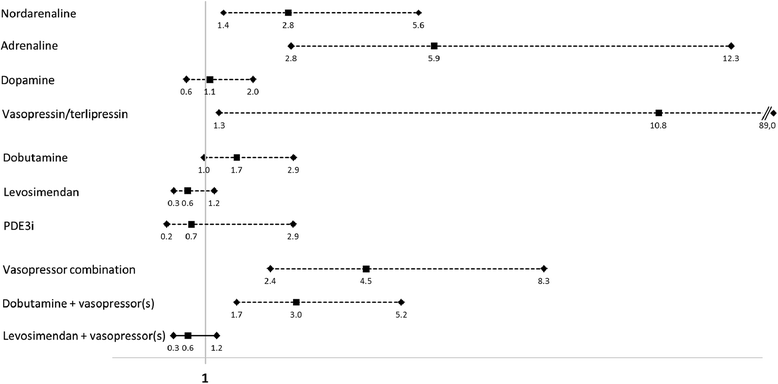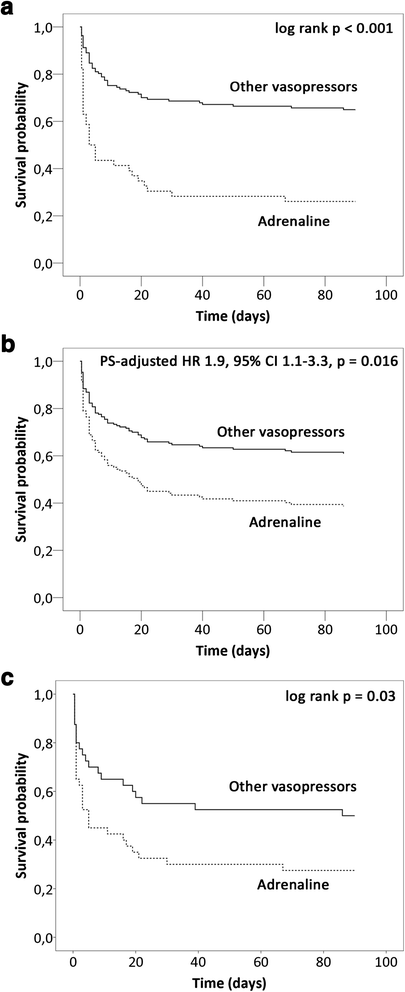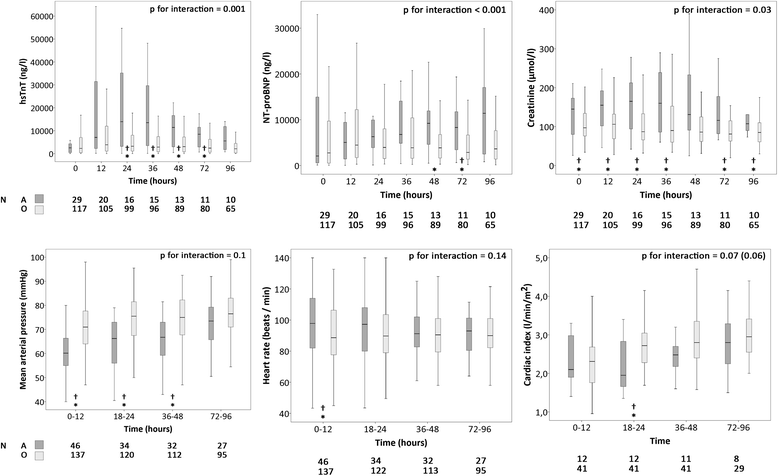Current real-life use of vasopressors and inotropes in cardiogenic shock - adrenaline use is associated with excess organ injury and mortality
- PMID: 27374027
- PMCID: PMC4931696
- DOI: 10.1186/s13054-016-1387-1
Current real-life use of vasopressors and inotropes in cardiogenic shock - adrenaline use is associated with excess organ injury and mortality
Abstract
Background: Vasopressors and inotropes remain a cornerstone in stabilization of the severely impaired hemodynamics and cardiac output in cardiogenic shock (CS). The aim of this study was to analyze current real-life use of these medications, and their impact on outcome and on changes in cardiac and renal biomarkers over time in CS.
Methods: The multinational CardShock study prospectively enrolled 219 patients with CS. The use of vasopressors and inotropes was analyzed in relation to the primary outcome, i.e., 90-day mortality, with propensity score methods in 216 patients with follow-up data available. Changes in cardiac and renal biomarkers over time until 96 hours from baseline were analyzed with linear mixed modeling.
Results: Patients were 67 (SD 12) years old, 26 % were women, and 28 % had been resuscitated from cardiac arrest prior to inclusion. On average, systolic blood pressure was 78 (14) and mean arterial pressure 57 (11) mmHg at detection of shock. 90-day mortality was 41 %. Vasopressors and/or inotropes were administered to 94 % of patients and initiated principally within the first 24 hours. Noradrenaline and adrenaline were given to 75 % and 21 % of patients, and 30 % received several vasopressors. In multivariable logistic regression, only adrenaline (21 %) was independently associated with increased 90-day mortality (OR 5.2, 95 % CI 1.88, 14.7, p = 0.002). The result was independent of prior cardiac arrest (39 % of patients treated with adrenaline), and the association remained in propensity-score-adjusted analysis among vasopressor-treated patients (OR 3.0, 95 % CI 1.3, 7.2, p = 0.013); this was further confirmed by propensity-score-matched analysis. Adrenaline was also associated, independent of prior cardiac arrest, with marked worsening of cardiac and renal biomarkers during the first days. Dobutamine and levosimendan were the most commonly used inotropes (49 % and 24 %). There were no differences in mortality, whether noradrenaline was combined with dobutamine or levosimendan.
Conclusion: Among vasopressors and inotropes, adrenaline was independently associated with 90-day mortality in CS. Moreover, adrenaline use was associated with marked worsening in cardiac and renal biomarkers. The combined use of noradrenaline with either dobutamine or levosimendan appeared prognostically similar.
Keywords: Adrenaline; Cardiogenic shock; Inotropes; Mortality; Propensity score; Survival; Vasoactive medication; Vasopressors.
Figures




Comment in
-
Increased mortality with the use of adrenaline in shock: the evidence is still limited.Crit Care. 2016 Sep 20;20:289. doi: 10.1186/s13054-016-1465-4. Crit Care. 2016. PMID: 27645141 Free PMC article. No abstract available.
References
-
- Goldberg RJ, Spencer FA, Gore JM, Lessard D, Yarzebski J. Thirty-year trends (1975 to 2005) in the magnitude of, management of, and hospital death rates associated with cardiogenic shock in patients with acute myocardial infarction: a population-based perspective. Circulation. 2009;119:1211–9. doi: 10.1161/CIRCULATIONAHA.108.814947. - DOI - PMC - PubMed
-
- Thiele H, Zeymer U, Neumann FJ, Ferenc M, Olbrich HG, Hausleiter J, et al. Intra-aortic balloon counterpulsation in acute myocardial infarction complicated by cardiogenic shock (IABP-SHOCK II): final 12 month results of a randomised, open-label trial. Lancet. 2013;382:1638–45. doi: 10.1016/S0140-6736(13)61783-3. - DOI - PubMed
MeSH terms
Substances
LinkOut - more resources
Full Text Sources
Other Literature Sources

